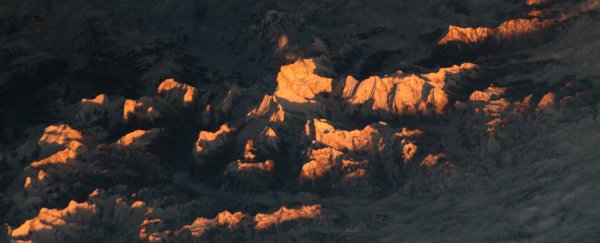Kangchenjunga is not to be underestimated. Earth's third-highest mountain rises over 8,500 metres (over 28,000 ft) above the ground.
But from the surreal elevation of space, the vastness of its towering peaks is almost lost… until you notice the clouds those peaks are peeking through.
This incredible shot of Kangchenjunga, which straddles the border of India and Nepal, was captured by crew aboard the International Space Station (ISS) in December, and reveals what the Himalayas look like as the Sun goes down, only moments before night blankets even the greatest of things.
 Kangchenjunga. (ISS Crew Earth Observations Facility/NASA)
Kangchenjunga. (ISS Crew Earth Observations Facility/NASA)
By virtue of its epic height, Kangchenjunga is one of the 'eight-thousanders': a select group of just 14 mountain peaks on Earth that stand taller than 8,000 metres.
Among the Himalayas, Kangchenjunga is the second tallest, bowing only to Mount Everest, which reaches almost 300 metres higher in elevation, and lies about 120 kilometres (75 miles) from Kangchenjunga in a westerly direction.
Both of these Himalayan peaks were first scaled within a few years of each other in the 1950s, although Kangchenjunga has never become as frequently visited by climbers, marking only hundreds of ascents overall, not several thousand like Everest.
Before the first known ascent of Kangchenjunga, local Sikkam people told British climbers Joe Brown and George Band not to climb to the very top, in case they offended a god living at the summit.
None were to know that only decades later, humanity itself would sail above even these towering crags, in a space station so high and removed, it could make even the homes of gods look small.
